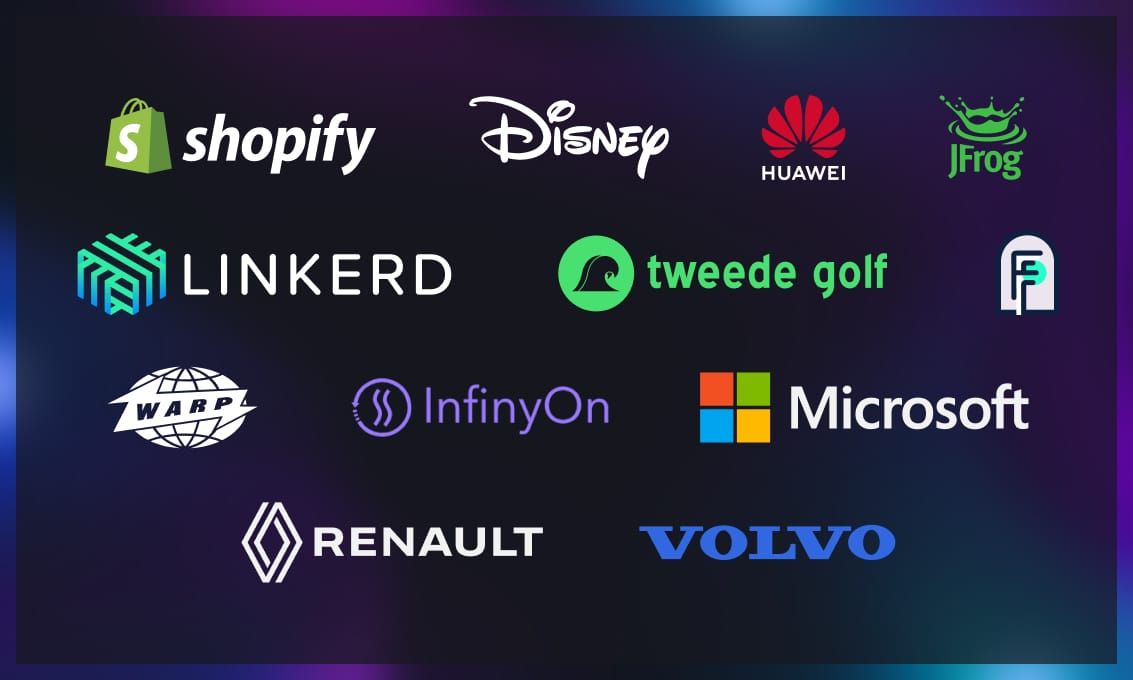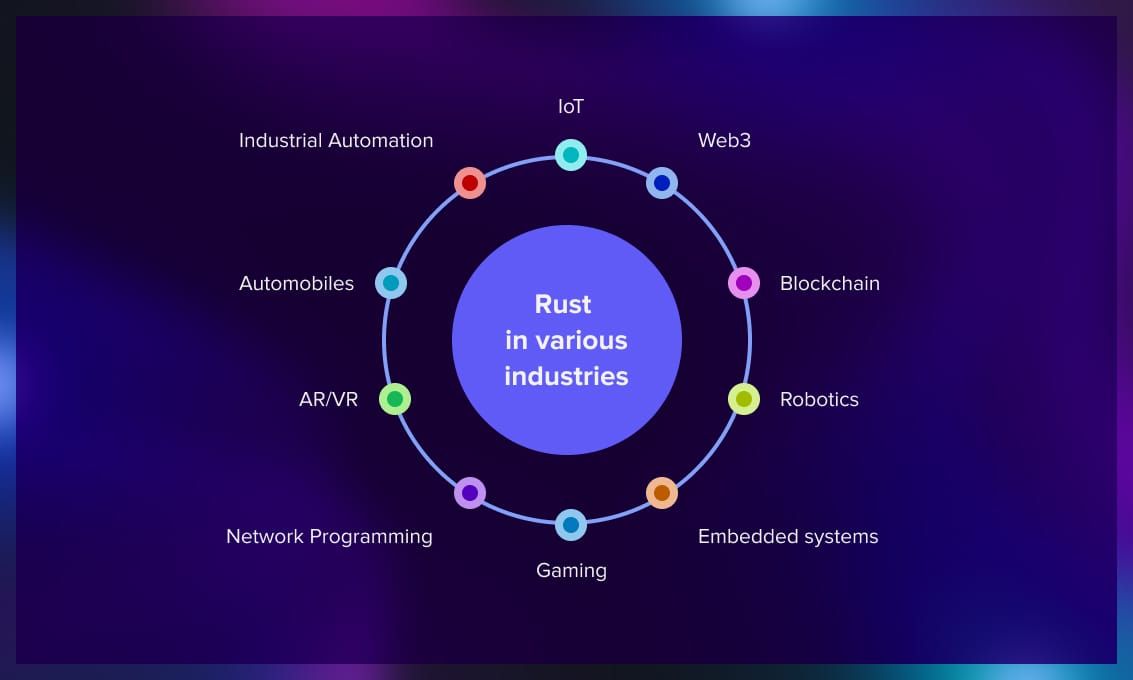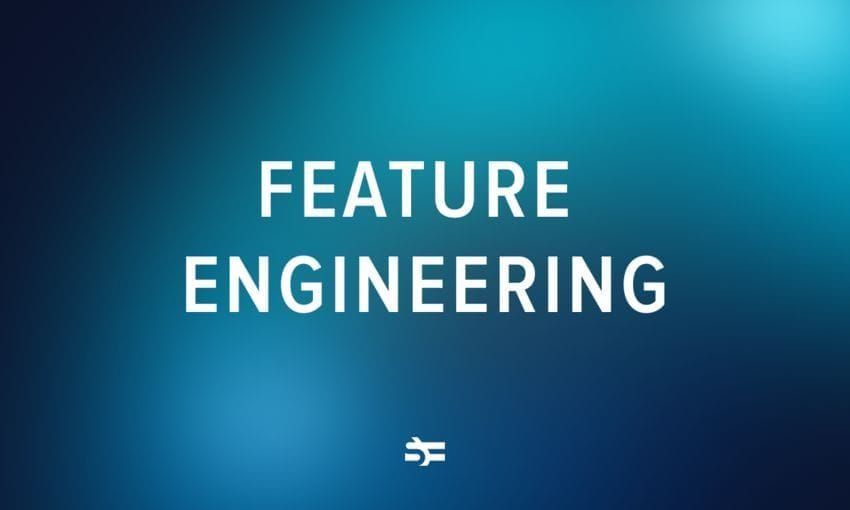Rust has seen increasing adoption by both big tech companies and startups in recent years. In this blog post, we will examine 12 prominent business applications of Rust in the real world, from Disney to the Falcon 9 launch.
Back in 2020, we wrote about the major market players which used Rust in their projects, including Dropbox, Coursera, Figma, Microsoft, and others. Since then, this programming language has gained more popularity, so it’s time to explore more success stories.
Why is Rust one of the most loved programming languages?
According to Stack Overflow’s Annual Developer Surveys, Rust has consistently ranked as one of the most desired and favored programming languages in recent years.
The reasons are:
- Performance and safety: Rust provides high performance similar to C and C++ while ensuring memory safety, preventing common bugs and security vulnerabilities.
- Versatility: Rust can be used for a wide range of applications, from web development to data analysis to artificial intelligence.
- Cross-platform compatibility: Rust is compatible with multiple platforms, including Windows, macOS, and Linux.
- Active community: Rust enthusiasts contribute to the language’s development, offering support and continuously adding new libraries and frameworks.
- Adoption by major companies: With backing from major tech companies, Rust is increasingly being used in critical and high-profile projects, further validating its capabilities and reliability.
Since its inception in 2006 by Graydon Hoare and subsequent development under Mozilla Firefox’s support starting in 2009, Rust has evolved significantly. Upon its release, the programming community quickly recognized Rust’s potential and advantages over more established languages like C and C++.
In 2021, the Rust Foundation was formed by major tech companies, including Amazon, Google, Huawei, Microsoft, and Mozilla. As a result, Rust practitioners include some of the most professional, innovative, and creative programmers, who implement amazing business cases using the powerful and transparent programming language: Rust.
Read more about the features of Rust in this post.
Which companies use Rust?

Companies from multiple domains leverage Rust to build high-quality software for specific purposes. These include giants like Disney and Shopify, as well as ambitious startups.
Microsoft
Microsoft has been rewriting core Windows libraries in Rust as part of its effort to improve security and eliminate bug classes.
Furthermore, Microsoft’s project called “Rust for Windows” allows developers to use any Windows API directly and seamlessly through the “windows” crate in Rust. This crate covers a wide range of Windows functionalities, including timeless functions, powerful graphics engines, traditional windowing functions, and user interface frameworks.
Shopify
Historically using the Ruby language for server-side programming, Shopify began deploying Rust in 2021 to develop YJIT, a new CRuby Just-In-Time (JIT) compiler that was integrated into Ruby 3.1. In performance tests, YJIT outperformed CRuby by 38%.
Shopify has also chosen Rust as its system programming language for building high-performance web servers to fully benefit from Rust’s consistency, performance, security, and interoperability.
Disney
Disney is utilizing Rust to develop its NCP GUI framework. The Native Client Platform v2 (NCPv2) framework, nicknamed “m5,” primarily uses Rust to target WebAssembly (WASM) to facilitate web deployment. This project, nearly three years in the making, has evolved to the point where the same rendering engine is now used across various platforms, from handheld devices to TVs and web pages.
Volvo
Volvo employs Rust to develop new software for its cars and continues to expand its usage. Here’s what Julius Gustavsson, a Technical Expert and System Architect at Volvo Cars Corporation, said about it in an interview:
We want to expand Rust here at Volvo Cars…There is no point in replacing already developed and well tested code, but code developed from scratch should definitely be developed in Rust… That is not to say that Rust is a panacea. Rust has some rough edges still and it requires you to make certain trade-offs that may not always be the best course of action. But overall, I think Rust has huge potential to allow us to produce higher quality code upfront at a lower cost which in turn would reduce our warranty costs, so it’s a win-win for the bottom line. Source
Renault
Renault emphasizes the importance of distributed security, which is why they made Rust mandatory for software development. Rust is integrated into their development processes and is used for various critical applications, including security software for heavy packet processing and Advanced Driver Assistance Systems (ADAS).
Rust is also employed to harden legacy code in mixed-security environments. Additionally, it is a key requirement in the new Software-Defined Vehicle Operating System (SDV OS) being developed in collaboration with Google, where it is essential for certain cross-safety communication modes.
Watch this video from the 2024 Rust Nation UK conference to learn more about how Rust is being applied at Renault.
Gama Solar Sail and Tweede golf
Gama Solar Sail, a company involved in space exploration, is among the organizations publicly utilizing Rust in their research. In January 2023, a SpaceX Falcon 9 rocket successfully placed its satellite into orbit.
Tweede golf, a software services company and a member of the Rust Foundation, provided the necessary services for the launch. They have an open-source repository that includes a library of Rust implementations of the Precision Time Protocol (PTP). PTP, a superior alternative to NTP (Network Time Protocol) in terms of accuracy, was instrumental in synchronizing time for the launch, underscoring its relevance and benefits in the space industry.
Huawei
Huawei aims to make communication system software more secure and reliable. The company has transitioned some of its C/C++ codebase to Rust to boost performance and security. To facilitate this transition, Huawei offers developers automation via the open-source C2Rust translator. This tool converts C code into Rust and then refines it, using source-to-source transformation.
Additionally, Huawei has contributed to the Rust development, including submissions to the Rust compiler to support the ARM AArch64 32-bit big-end ILP32 chipset, used in Huawei’s devices. These contributions allow the company and its partners to execute Rust-native programs on these widespread network hardware architectures.
JFrog
JPFrog, a provider of DevOps solutions, joined the non-profit Rust Foundation in 2022, aiming to further develop the Rust language functionality by offering their security expertise, detection mechanisms for data vulnerability, and research of emerging threats.
Securing the software supply chain can’t be achieved with a one-time effort – it requires ongoing commitment, plus a multi-layered approach, and we believe memory-safe languages play a big role in that plan. By working hand-in-hand with the Rust Foundation, we can ensure this cornerstone programming language remains a recommended best practice in the development of modern, secure software.
Stephen Chin, VP of Developer Relations at JFrog.
Linkerd
Linkerd, a leading service mesh, developed its Linkerd2-proxy in close connection with the adoption of Rust. The Linkerd team, transitioning from languages like Go, Scala, or even the conventional proxy language C++, opted for Rust to meet the demands of service mesh proxies. These requirements included CPU usage limitations, low latency, and robust security, especially critical given the sensitivity of data handled by the proxy, such as financial transactions and personal information.
Key motivations for selecting Rust included its efficiency in resource management and its ability to provide data security and memory safety—a critical issue for a service mesh proxy.
Fermyon
Fermyon Cloud simplifies the deployment of WebAssembly-based applications and microservices. With its Spin build tool, which is implemented in Rust, developers can easily compile and package applications for WebAssembly and deploy them to Fermyon Cloud. This streamlines the deployment process as Fermyon’s toolchain takes care of all configuration and deployment steps.
Warp
Warp, a terminal emulator, leverages Rust and its technology stack, including WebAssembly, to provide cross-platform support. For UI rendering, Warp utilizes the GPU through the Metal API on MacOS, a choice driven by the platform’s popularity among developers and the availability of robust debugging tools.
InfinyOn
InfinyOn, a company specializing in real-time event streaming, uses Fluvio, a dynamic data programmability platform built in Rust, which is gaining traction among developers and the open-source community.
Whereas traditional data platforms from the Java era are cumbersome, memory-intensive, and difficult to operate, InfinyOn eliminates the need for ETL tools, offering a cost-effective and secure solution with up to 80 times less memory usage.
Miscellaneous
- Parallel Systems, a company specializing in zero-emission automated electric freight trains, developed their technology stack using the Rust programming language.
- OneSignal, a messaging push provider, has been utilizing Rust since 2017 to power its push notifications, email, SMS, and in-app self-service customer engagement solutions. The company offers a Rust Client for these services.
- CurrySoftware GmbH fully developed its multi-tenant On-Site CurrySearch in Rust.
- Zeplin built its Adobe XD CC integration in Rust.
- Pollen Robotics created Rust-based tools for robot development.
We could extend this list, but instead, here are some ideas on how Rust can benefit your business, regardless of the industry you’re in.
Rust in various industries

Rust finds applications in virtually every modern industry, from industrial automation to Web3, blockchain, and robotics.
Rust for IoT
Rust’s ability to manage concurrency, and generate small, efficient binaries makes it well-suited for the demanding requirements of IoT devices.
Its minimal runtime and control over memory layout cater to IoT’s security, fast operation and resource-constrained needs, while the enthusiastic developer community provides strong support for IoT projects.
Rust programming to facilitate Web3 and blockchain
Rust has become a popular language for Web3 and blockchain development due to its memory safety, concurrency support, performance, and growing ecosystem. It is the main language for the Solana ecosystem, smart contracts, and more. Additionally, many Web3 projects operating in a WASM runtime, such as NEAR, Internet Computer, Aptos, Massa, Oasis Network, and Subspace, are built using Rust. The language is employed for Tezos smart rollups.
Rust language for robotics
While C++ has been the standard language for robotics, Rust is emerging as a better alternative. Its main advantage compared to C++ is its memory safety. Rust offers concurrency support, and a growing ecosystem of libraries and tools specifically for robotics. Secondly, Rust can easily integrate with existing codebases, including the widely used Robot Operating System (ROS). Lastly, Rust’s performance, small footprint, and strong error-handling semantics make it well-suited for managing the complexity of robotics systems, including hardware control and AI acceleration. These factors contribute to Rust’s increasing popularity in the robotics community.
Rust for embedded systems
The Rust programming language is well-equipped for creating low-level hardware drivers and operating systems due to its robust features. Rust has established itself as a top choice for embedded systems development. These systems find applications across various industries, including medicine, aerospace, and auto transport.
Rust development for automobiles
Automobiles are becoming more connected, and thanks to Rust’s memory safety and concurrency, it is successfully used to develop reliable car software. Rust can be used to develop applications for various car components, including engine control units, infotainment systems, and advanced driver assistance systems (ADAS). C/C++ have traditionally been used in automaking and are still dominant. However, carmakers like Renault and Volvo are already using Rust as part of the novel SDV (software-defined vehicle) concept. Additionally, the AUTOSAR consortium, which brings together companies like BMW, Mercedes, and Ford, has formed a working group to investigate Rust.
AR/VR & Rust language
Rust’s ability to handle low-level hardware operations and interface with hardware devices is particularly advantageous in AR/VR. Rust code also offers simplicity and versatility and, most importantly, seamlessly integrates with existing AR/VR frameworks and libraries, allowing developers to leverage the resources and tools available in the AR/VR ecosystem.
Gaming with Rust
Rust’s combination of high performance and memory safety is perfect for developing games that demand a lot of processing power, low latency, and robust performance, such as open-world games or plays with complex physics engines. Rust’s ability to manage multiple threads effectively is crucial for building complex game engines.
Rust for network programming
The low-level control capabilities of the Rust language make it a top choice for network application development. Its concurrency features enable efficient management of multiple network connections, while memory safety helps develop secure network code.
Watch this video from Google Open Source to learn how to introduce Rust to an existing project.
Conclusion
Rust has proven to be a powerful programming language that offers numerous benefits for businesses across various industries in developing reliable and efficient software systems.
Rust’s growing ecosystem and active community strengthen the language’s power, providing a wealth of libraries, frameworks, and tools to streamline development and enhance productivity. The language’s interoperability with other languages, such as C and C++, allows companies to gradually integrate Rust into their existing codebases.
Adopting Rust can give your team a competitive advantage in delivering secure, efficient, and high-performing software products.




.jpg)
.jpg)

